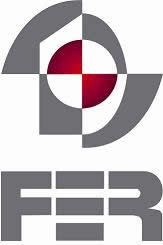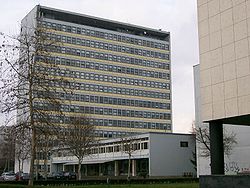
Faculty of Electrical Engineering and Computing, University of Zagreb
Encyclopedia

EECS
EECS may refer to:* Electrical Engineering & Computer Science* European Energy Certificate System...
' onMouseout='HidePop("2538")' href="/topics/Abbreviation">abbr
Abbreviation
An abbreviation is a shortened form of a word or phrase. Usually, but not always, it consists of a letter or group of letters taken from the word or phrase...
: FER) is one of the top faculties of University of Zagreb
University of Zagreb
The University of Zagreb is the biggest Croatian university and the oldest continuously operating university in the area covering Central Europe south of Vienna and all of Southeastern Europe...
. The faculty is regarded as "the largest technical faculty and the leading educational as well as research-and-development institution in the fields of electrical engineering and computing in Croatia
Croatia
Croatia , officially the Republic of Croatia , is a unitary democratic parliamentary republic in Europe at the crossroads of the Mitteleuropa, the Balkans, and the Mediterranean. Its capital and largest city is Zagreb. The country is divided into 20 counties and the city of Zagreb. Croatia covers ...
."
FER owns four buildings situated in the Zagreb
Zagreb
Zagreb is the capital and the largest city of the Republic of Croatia. It is in the northwest of the country, along the Sava river, at the southern slopes of the Medvednica mountain. Zagreb lies at an elevation of approximately above sea level. According to the last official census, Zagreb's city...
neighbourhood of Martinovka, Trnje
Trnje
Trnje is a district in the City of Zagreb, Croatia. According to the 2001 census, the district had 45,267 residents. It is located in the central part of the city, south of Donji grad across the railway , east of Trešnjevka , west of Pešćenica , and north of the river Sava...
. The total area of the site is 43308 m² (51,795.9 sq yd). , the Faculty employs about 260 teaching and research staff, about 50 research associates, and about 100 administrative and support staff. In the academic year 2004/2005, the total number of students was about 3,300 in the undergraduate, and about 500 in the graduate program.
As of school year 2004/2005, when the implementation of the Bologna process
Bologna process
The purpose of the Bologna Process is the creation of the European Higher Education Area by making academic degree standards and quality assurance standards more comparable and compatible throughout Europe, in particular under the Lisbon Recognition Convention...
started at the University of Zagreb, the faculty has two baccalaureus programmes (each lasting 3 years):
- Electrotechnics and information technologyInformation technologyInformation technology is the acquisition, processing, storage and dissemination of vocal, pictorial, textual and numerical information by a microelectronics-based combination of computing and telecommunications...
- ComputingComputer scienceComputer science or computing science is the study of the theoretical foundations of information and computation and of practical techniques for their implementation and application in computer systems...
After receiving a bachelor's degree, students can take part in one of three master's programmes:
- Electrotechnics and information technology
- Information and communication technology
- Computing
Organisation

Academic department
An academic department is a division of a university or school faculty devoted to a particular academic discipline. This article covers United States usage at the university level....
s:
- Applied Physics
- Applied Computing
- Applied Mathematics
- Fundamentals of Electrical Engineering and Measurements
- Electric Machines, Drives and Automation
- Power Systems
- Telecommunications
- Electronic Systems and Information Processing
- Control and Computer Engineering in Automation
- Electroacoustics
- Electronics, Microelectronics, Computer and Intelligent Systems
- Radiocommunications and Microwave Engineering
History
The Faculty of Electrical Engineering ' onMouseout='HidePop("12592")' href="/topics/Abbreviation">abbrAbbreviation
An abbreviation is a shortened form of a word or phrase. Usually, but not always, it consists of a letter or group of letters taken from the word or phrase...
: ETF) was formed on 1 July 1956 when the College of Engineering of the University of Zagreb was divided into ETF and three other new faculties. The faculty existed under this name until 7 February 1995 when it was renamed to its current name.
In 1956, the first curriculum was formed, offering students programme called "Study of Electrical Engineering". The faculty was divided into two departments, one for weak current
Electric current
Electric current is a flow of electric charge through a medium.This charge is typically carried by moving electrons in a conductor such as wire...
(Odjel za slabu struju) and another for the strong current (Odjel za jaku struju). This was later referred to as the ETF-1 programme. The Faculty changed its curriculum in 1967, when the ETF-2 curriculum introduced a division of studies into electrical power systems, electronics, electrical machinery and automation. In 1970, the ETF-3 curriculum introduced further specializations, such as nuclear power systems and computing. There was also an ETF-4 curriculum later.
In 1994 name of the faculty changed, and the curriculum was changed from ETF-4 to FER-1. A separate study called "Study of Computing" was formed, so the faculty from then on offered two different degrees - one was the existing diplomirani inženjer elektrotehnike, or graduate engineer
Engineer's degree
An engineer's degree is an advanced academic degree in engineering that is conferred in Europe, some countries of Latin America, and a few institutions in the United States....
of electrical engineering, and the new one was diplomirani inženjer računarstva, or graduate engineer
Engineer's degree
An engineer's degree is an advanced academic degree in engineering that is conferred in Europe, some countries of Latin America, and a few institutions in the United States....
of computing. In 2004 FER-1 was transformed to FER-2, to conform to the Bologna process
Bologna process
The purpose of the Bologna Process is the creation of the European Higher Education Area by making academic degree standards and quality assurance standards more comparable and compatible throughout Europe, in particular under the Lisbon Recognition Convention...
. This involved, among other things, changing the length of the essential course set from four semesters to two semesters, the renaming of the first study program to include the term information technology
Information technology
Information technology is the acquisition, processing, storage and dissemination of vocal, pictorial, textual and numerical information by a microelectronics-based combination of computing and telecommunications...
, and the reworking of the program subdivisions so that they each include five specialized modules.
Deans
- Anton Dolenc (1956–1957)
- Danilo BlanušaDanilo BlanušaDanilo Blanuša was a Croatian mathematician, physicist, engineer and a professor at the University of Zagreb. He was Serb and he was born in Austro-Ugarska monarchy ....
(1957–1958) - Božidar Stefanini (1958–1959)
- Vatroslav Lopašić (1959–1960)
- Hrvoje PožarHrvoje PožarHrvoje Požar was a Croatian engineer and one of the top world scientists at the Croatian Academy of Sciences and Arts....
(1960–1962) - Vladimir Matković (1962–1964)
- Radenko Wolf (1964–1966)
- Vladimir Muljević (1966–1968)
- Hrvoje PožarHrvoje PožarHrvoje Požar was a Croatian engineer and one of the top world scientists at the Croatian Academy of Sciences and Arts....
(1968–1970) - Vojislav Bego (1970–1972)
- Zlatko Smrkić (1972–1974)
- Zvonimir Sirotić (1974–1976)
- Uroš Peruško (1976–1978)
- Ante Šantić (1978–1980)
- Berislav Jurković (1980–1982)
- Milan Sodan (1982–1984)
- Nedžat Pašalić (1984–1986)
- Leo Budin (1986–1988)
- Vladimir Naglić (1988–1990)
- Ivan Ilić (1990–1992)
- Danilo Feretić (1992–1994)
- Stanko Tonković (1994–1996)
- Stanko Tonković (1996–1998)
- Slavko Krajcar (1998–2000)
- Slavko Krajcar (2000–2002)
- Mladen Kos (2002–2004)
- Mladen Kos (2004–2006)
- Vedran Mornar (2006–2010)
- Nedjeljko Perić (2010–present)
Notable alumni
- Ante MarkovićAnte MarkovicAnte Marković was a statesman of the former Yugoslavia. He was the last prime minister of the Socialist Federal Republic of Yugoslavia.- Early life :...
, last prime ministerPrime ministerA prime minister is the most senior minister of cabinet in the executive branch of government in a parliamentary system. In many systems, the prime minister selects and may dismiss other members of the cabinet, and allocates posts to members within the government. In most systems, the prime...
of SFRYSocialist Federal Republic of YugoslaviaThe Socialist Federal Republic of Yugoslavia was the Yugoslav state that existed from the abolition of the Yugoslav monarchy until it was dissolved in 1992 amid the Yugoslav Wars. It was a socialist state and a federation made up of six socialist republics: Bosnia and Herzegovina, Croatia,... - Branko Jeren, Croatian minister of Science and Technology 1993-1995.
Notable professors
- Danilo BlanušaDanilo BlanušaDanilo Blanuša was a Croatian mathematician, physicist, engineer and a professor at the University of Zagreb. He was Serb and he was born in Austro-Ugarska monarchy ....
, a mathematician, inventor of second and third known snarkSnark (graph theory)In the mathematical field of graph theory, a snark is a connected, bridgeless cubic graph with chromatic index equal to 4. In other words, it is a graph in which every vertex has three neighbors, and the edges cannot be colored by only three colors without two edges of the same color meeting at a...
(was dean of FER in the 1957-58 school year)
KSET
The Electrical Engineering Student Club (CroatianCroatian language
Croatian is the collective name for the standard language and dialects spoken by Croats, principally in Croatia, Bosnia and Herzegovina, the Serbian province of Vojvodina and other neighbouring countries...
: Klub studenata elektrotehnike, abbr: KSET) is a student association founded by students of the Croatian Faculty of Electrical Engineering, and plays an active role in the social life of the University of Zagreb
University of Zagreb
The University of Zagreb is the biggest Croatian university and the oldest continuously operating university in the area covering Central Europe south of Vienna and all of Southeastern Europe...
and Zagreb in general. The club is part of a larger building complex of its native faculty.

